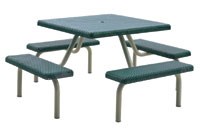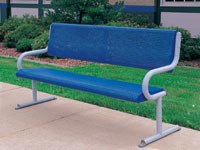Thermoplastic Powder for Outdoor Furniture
Outdoor furniture has traditionally been coated with various plastisol and PVC coatings. But, a new paradigm is beginning to take shape with the increasing use of modified polyethylene powder coatings...
Thermoset powder coatings have been the driving force behind the wide-spread acceptance of powder coated finishes for several reasons. These powders provide excellent appearance, are environmentally friendly and have high transfer efficiency. Plus, thermoset powders are applied using a process very similar to liquid painting.
Even though thermoset powders are widely used and well understood, they aren't suitable for some applications, especially those that require a coating with excellent mechanical properties such as flexibility, strength and impact resistance. Therefore, many finishers have continued to use various plastisol and PVC coatings for these applications. Perhaps this is because many finishers are either not aware of or are unfamiliar with thermoplastic powder coatings.
Featured Content
But, some finishers have seen the value of thermoplastic powders. These powders meet, and sometimes exceed, the functional properties of plastisol and PVC coatings, yet they provide all of the benefits of the more familiar thermoset powders.
A Paradigm Shift
Wausau Tile (Wausau, WI) manufactures outdoor and site furniture, including picnic tables and restaurant chairs and tables. Because these products are used in some extreme environments, they have very demanding corrosion, durability and strength requirements.
Until a couple of years ago, Wausau sent these parts to a job shop where they were finished in much the same way that all parts of this type were finished. The process was fairly involved, requiring three layers of coating-plastisol, powder and clear powder. Not only was the process involved, but the job shop was fairly far from Wausau. Consequently, Wausau began to look for a shop closer to home that could finish its parts with a PVC coating.
So, Wausau Tile asked Crystal Finishing, a local job shop, if it would finish the company's parts with PVC. However, Mark Matthiae, the owner of Crystal Finishing, had some concerns about PVC coating. "After I looked into it, I saw the hazards of PVC," said Mr. Matthiae. "It's not a healthy environment when you're coating, and the odor is pretty bad. I also asked Wausau if it wanted to sell worldwide, since you can't ship PVC coatings into some European countries. Finally, I said, 'If I can come up with something better, would you consider it?'
It just so happened that at the same time Mr. Matthiae was working with a potential supplier, Innotek Powder Coatings, on another project. Mr. Matthiae mentioned that he was looking for a coating for outdoor furniture. Innotek suggested that he look into its PolyArmor® modified polyethylene powder coating. After several discussions and some testing, Mr. Matthiae felt confident that he had found a coating that would meet all of Wausau's requirements. "The thermoplastic is such a good coating. It is much cleaner and healthier and more environmentally friendly. Plus, they can be shipped worldwide since it is PVC free," stated Mr. Matthiae.
Since Wausau was one of the first outdoor furniture manufacturers to switch to modified polyethylene powder coatings, the change represented a significant shift from the current industry practice. According to Mr. Matthiae, Wausau is now setting the standard in the outdoor furniture industry.
Better Coating, Lower Cost
Switching to a modified polyethylene powder coating (thermoplastic) has given Wausau Tile a more durable, better looking coating while lowering the company's finishing costs.
Because of the high demands placed on the coating, it was imperative that the thermoplastic powder match the functional qualities of Wausau's previous coating. "It turned out we gave them a product that lasts longer. The product has an extremely tough finish, and they have had zero field complaints," explained Mr. Matthaie.
Not only does the powder meet all Wausau's functional requirements, but it looks better too. With the previous three layer coating used by Wausau, the plastisol was a different color than the color powder coating. The different colors magnified any scratch in the coating. But, since the thermoplastic powder can be applied in one layer, any scratches blend in with the rest of the coating. Since the powder is applied at a lower film build it prevents runs and drips, and the powder provides good edge coverage.
With Crystal Finishing applying the powder coating, Wausau was able to reduce its finishing costs by 25%. One reason for the lower finishing costs is that the powder can be applied approximately half as thick as plastisol and PVC coatings while still providing the same performance. "Even though the material cost is more for thermoplastic, the end product costs less because you apply it at a thinner milage and it weighs less," said Mr. Matthiae. The modified polyethylene weighs approximately 30% less than vinyl powder and 40% less than plastisol depending on the amount of filler. This makes a significant difference when you're buying by the pound.
A second reason Wausau's finishing costs were reduced is because of the way in which the powder is applied. Crystal Finishing uses a simple, five-step fluidized bed process to coat the parts:
- Alkaline preclean
- Blast
- Preheat
- Fluidized bed powder coat
- Post-heat
The preheat stage is necessary to heat the part before it is dipped into the fluidized bed. Preheating the part allows the powder to melt and flow across the part. The thermoplastic powder does not need to be cured, but Crystal Finishing applies a post-heat to complete the flow and leveling of the powder. This process is much simpler than the one used by Wausau Tile's previous finisher, which required a cleaning stage, three coating stages and three curing stages. So, Crystal Finishing was able to save Wausau Tile money because the fluidized bed powder process is less expensive to operate and the fluidized bed process is much more productive.
Fluidized bed powder coating is repeatable and easy to control. According to Mr. Matthiae, "Once you master it, you can duplicate the process easily and give a consistent quality. We've found that the product performs day in and day out. If everybody follows the parameters we have set, we have very good looking parts."
The modified polyethylene powder process also makes dealing with rejects much easier. This is because once thermoplastic powders have been hardened, they can be reheated and the coating will remelt and reflow, unlike a thermoset powder or a PVC coating which needs to be burned off. Thanks to this capability, Crystal Finishing never has to throw away a part.
The switch to a thermoplastic powder was a significant change that opened up new markets for both Wausau Tile and Crystal Finishing. Wausau Tile can now sell its product worldwide, and Crystal Finishing has a new process ideal for many other parts, including part handling carts, outdoor lighting fixtures and automotive parts. While the modified polyethylene powder coating only represents 5% of Crystal Finishing's current business, Mr. Matthiae said it's growing rapidly. According to Mr. Matthiae, you can talk about the new markets and the cost advantages all you want, but the real question to him is do you want a better coating.
RELATED CONTENT
-
Improving Transfer Efficiencies in Coating Operations
There are many methods for addressing electrostatic grounding in metal painting processes, and Tim Ulshafer from Mueller Electric says the best method for your process is a simple and worthwhile exercise.
-
Developments and Trends in Powder Coating
New solutions for powder coating centers combine powder preparation, conveyance, dosing and color changes into a fully automated, closed system.
-
Coating Systems with the Best Long-Term Performance
The best protection against corrosion and UV exposure, says Axalta’s Mike Withers, is electrocoat and a super durable powder coating.


.JPG;width=70;height=70;mode=crop)



















